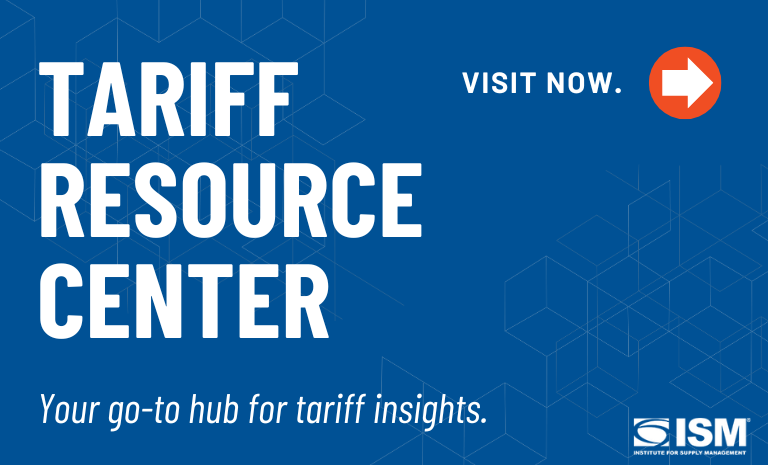Report On Business® Roundup: June Manufacturing PMI®

The release of the Manufacturing ISM® Report On Business® on Tuesday didn’t call for early fireworks, though the headline number of 49 percent for June exceeded projections and likely elicited a sigh of relief among investors.
However, as has been the case in recent months, a deeper dive in the data continues to reveal yellow and (potential) red flags — especially in a world where a continuing tariffs “mess,” as one panelist put it, has supply chain implications that far overshadow even more geopolitical turmoil in the Middle East.
That dynamic is intensified with the clock ticking to a July 9 deadline for the 90-day tariff pause on most nations, Susan Spence, MBA, Chair of the Institute for Supply Management® (ISM®) Manufacturing Business Survey Committee, told a conference call of reporters. President Donald Trump has said he is not planning to extend that moratorium, but he has quickly changed or reversed course many times before, which only heightens uncertainty.
9 mentions of tariff/tariffs in the comments section of the June ISM Manufacturing PMI pic.twitter.com/gRMgvRyPmk
— Kevin Gordon (@KevRGordon) July 1, 2025
Spence said it’s too soon to tell the impact of the conflict between Israel and Iran. But she added, “The biggest global conflict is about trade policy and what will happen with each country. The tariff schedule is, in the opinion of panelists, having a bigger impact than anything else. Obviously, tensions in the world geopolitically can be severe, but that’s not what we’re seeing in the majority of comments.”
The ratio of negative to positive sentiment in panelists’ comments was 11-to-1. Given that and the subindex readings revealing weak demand, shrinking employment and backlogs, and higher prices, it’s a minor miracle the Manufacturing PMI® gained 0.5 percentage point compared to May. An unexpected and possibly untenable increase in the Production Index saved the day.
A month ago, Spence raised concerns about production, saying that current levels of imports, backlogs and inventories were a less-than-ideal recipe to get factory lines humming. In June, the New Orders (46.4 percent), Inventories (49.2 percent), Imports (47.4 percent) and Backlog of Orders (44.3 percent) indexes remained in contraction, but the Production Index registered 50.3 percent, up 4.9 percentage points compared to the previous month.
At first glance, the math “doesn’t make a lot of sense,” Spence said. The production gain, she said, could be attributed to companies placing heavy orders during the tariff pause, which is supported by the Imports Index elevating 7.5 percentage points in June. That reversed the May loss that brought that index to a Great Recession-level low.
Also, the Customers’ Inventories Index registered 46.7 percent, still in “too low” territory but a 2.2-percentage point increase, suggesting that companies’ customers are finally starting to replenish their stocks.
But those trends have to continue, Spence said. With no relief on costs — the Prices Index rose to 69.7 percent, remaining at its highest levels since 2022 — that’s not a sure thing. “I’m not certain how that can hold without the replenishment of new orders on the front end,” she said. “Prices have been going up nine months in a row and employment is continuing to contract as companies continue to right size their cost structures with lower new orders and backlogs.”
Spence continued, “It’s great to see production up, but it’s got to be sustained by the pipeline with new orders. I’m still worried about that.”
ISM Manufacturing has been below 50 every month since October 2022 except for during january & February this year...
— Peder Du Rietz, CFA (@DuRietzPeder) July 1, 2025
Leading subindices like new orders & production are quite weak even if the latter experienced a bit of a bounce. pic.twitter.com/PdGRJtNEug
Among the readings to make supply managers reach for an antacid: The Employment Index dropped to 45 percent, with 3.2 panelist comments on staff reductions for every one on hiring, one of the widest ratios since ISM began tracking employment comments.
Finally, the share of manufacturing gross domestic product in strong contraction (defined as an industry-specific PMI® of 45 percent or lower) was 25 percent in June, up from 5 percent the previous month. And the largest manufacturing industry — Chemical Products, at a fifth of sector GDP — had a dreadful June, with strong contraction overall and in employment.
Chemical Products supplies materials to the other 17 manufacturing industries, making it as much of a bellwether industry as is possible. “An industry like that in contraction is worrisome to me,” Spence said on ISM’s LinkedIn Live broadcast on Tuesday.
Apparel, Leather & Allied Products having a good month is a positive, she said, but it’s not going to swing the sector because that industry makes up a small share of sector GDP. “(Chemical Products) is a driver of the manufacturing economy,” Spence said.
The Report On Business® roundup:
Barron’s: Manufacturing Activity Remained Weak in June. Tariffs Are to Blame. “Overall, it’s a weak report. … So far, investors have shrugged off most tariffs news, likely believing things will get better eventually. Better hasn’t been reflected in the current PMI® data, however.”
Bloomberg: U.S. Manufacturing Activity Contracted in June for a Fourth Month. “Bookings contracted by the most in three months and have been shrinking for the past five months, likely a reflection of higher tariffs and a general slowdown in the economy. (The Backlog of Orders Index) fell 2.8 points, the most in a year, to 44.3 percent. Backlogs have contracted a record 33 straight months.”
CNBC: ISM Manufacturing PMI® Surprises to Upside. “Basically, this is the highest level (for the PMI®) since February,” Santelli said. “(The Prices Index), we would rather have going down, but it’s going up … 69.7 percent, higher than we were expecting and the highest going back to April of this year. And prices paid being higher has a whiff of inflation attached to it.”
Mace News: Manufacturing Stays in Contraction in June as Uncertainty Over Trade Conflicts Keeps Firms on Sidelines, Leading to Weak Demand, More Layoffs. “Among comments from ISM member firms, a machinery maker said, ‘The tariff mess has utterly stopped sales globally and domestically. Everyone is on pause. Orders have collapsed.’ ‘Tariffs continue to cause confusion and uncertainty for long-term procurement decisions,’ a company in the computer and electronic products category agreed.”
MarketWatch: U.S. Manufacturing Slump Shows Little Sign of Ending Amid Ongoing Trade Wars, ISM Says. “The U.S. stock market has roared back to life after the White House dialed back the tariffs, but the real economy hasn’t exactly caught up. … Businesses are trying to get foreign suppliers to reduce prices, but if they don’t succeed, they will either have to accept lower profits or try to pass on the price increases to customers. It’s a hot potato.”
RESILIENT ECONOMY: MANUFACTURING IMPROVES, JOB OPENINGS BEAT EXPECTATIONS
— Samsolid (@samsolid57) July 1, 2025
ISM Manufacturing PMI rose to 49.0, signaling slight progress, while JOLTS job openings came in at 7.77M vs 7.32M expected, underscoring labor market strength.
Fed cut soon?
Reuters: U.S. Manufacturing Mired in Weakness as Tariffs Bite. “The survey joined weak data on the housing market, consumer spending and swelling unemployment rolls that have suggested the economy's underlying momentum slowed further in the second quarter even as gross domestic product probably rebounded as the drag from a record trade deficit faded due to falling imports.”
The Wall Street Journal: U.S.’s Sluggish Factory Activity Persists Amid Trade Uncertainty. “(The New Orders Index) shrank for a fifth consecutive month, while the Employment Index dropped further into contraction as firms managed their head counts, as opposed to hiring. Tariff-induced prices growth accelerated, with the last three months having brought the (Prices Index’s) highest readings since June 2022.”
ISM’s Services PMI® will be unveiled on Thursday, and the Hospital PMI® on July 8. For the most up-to-date content on the reports under the ISM® Report On Business® umbrella, use #ISMPMI on X, formerly known as Twitter.

